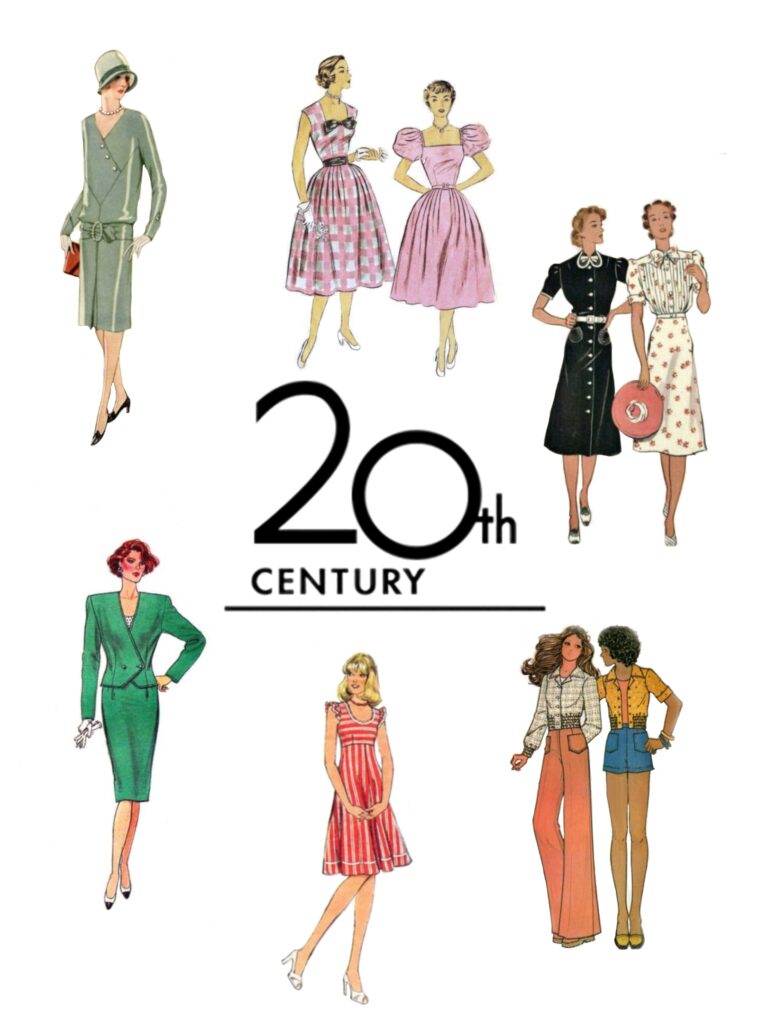By Andrea Powell Azorin
Edited by Inés Peyró
Since the beginning of time, fashion has been a way for each and every one of us to express ourselves, how we feel, or how wealthy we are. One could even say it’s a way for us to communicate and understand each other more. And although it’s a concept that plays a big role in our everyday lives, people sometimes forget its importance. Fashion is, among other things, something used to represent the historic period we are living in, and it shows us how people lived during their time and why they wore that kind of clothes. To get a clearer idea of this, we will be looking at what fashion looked like all over the 20th Century.
1900s – 1910s
During the beginning of this decade, the Edwardian era, it was still quite common among women to wear boned corsets; these were worn under tailored skirts and blouses. Similarly, men wore tailored, short-fitting trousers and button-up dress shirts. They were also accustomed to wearing different coats throughout the day, notably “manteaux automobiles” (also known as car coats) which were worn mostly during the winter.

The start of World War I in 1914 heavily influenced the change in women’s fashion: their clothing became more practical as they had to prepare to start working. They were introduced to shirtwaists and tailored suits which were all presented in dark colours, reflecting the depressing time they were living through. Suits became popular among men, entering a more formal and stricter era.
1920s – 1930s
With WWI being over, “luxurious” fabrics became more affordable and it became extremely common for people to make their own clothes at home. Women started experimenting with different out-of-the-box styles in the 1920s, such as flapper dresses, usually worn with strings of pearls or fur collars. Although men would still occasionally wear suits, sportswear now grew increasingly popular.
Influenced by Hollywood films, fashion in the 1930s was elegant and sophisticated. Evening dresses were long and backless, decorated with flowers or bows, and colours such as maroon and plum became trendy. Men wore cuffed trousers and trench coats, and those who couldn’t afford suits because of the Great Depression had to wear less formal clothing.
1940s – 1950s
With the start of World War II, fashion once again faced restrictions and cheaper fabric was to be used for clothing. Women wore simple knee-length skirts, blouses, and fitted shoulders pads became popular for various sorts of clothing, while men’s clothes gradually became looser and more casual.
In the 1950s, women’s fashion became more luxurious; it introduced big skirts and bold colours/patterns. More glamourous looks were also very popular during this decade, which included empire dresses, stilettos and beehive hairstyles. Men’s fashion became more stylish, trying looks such as the classic jeans, white t-shirt, leather jacket and slicked-back hair combo.
1960s – 1970s
At the beginning of the 1960s, it became very popular for women to wear miniskirts (a trend introduced by the fashion designer Mary Quant). These miniskirts were covered in bold patterns and paired with go-go boots; a look which was associated with mod fashion – a fashion that also included wearing shift dresses. Additionally, women started wearing trousers more often, as it was now deemed acceptable for them to do so. Later that decade, the hippie movement introduced all kinds of new styles to both men and women, such as: bell-bottom trousers, tie-dye and peace signs – which were meant to show the value of free love and freedom of expression.
This hippie style was continued into the beginning of the 1970s. This decade is considered as a fun and bohemian era, not just fashion wise. It came with more outgoing clothing pieces including flares, platform shoes, jumpsuits and maxi dresses. Some of these items, especially bell-bottoms were also very popular among men.
1980s – 1990s
Fashion in the 1980s was influenced by TV shows, music videos, and it popularised fitness clothing a lot. Many trends revolved around bright neon colours which were imprinted on leotards and leg warmers for women and on tracksuits for men. Aside from that, this decade’s fashion also relied on jeans and denim jackets, which were often combined. Makeup-wise, it also made room for bold eyeliner/eyeshadow, and spiked hair, which were all inspired by the punk scene.
The grunge style is what heavily influenced the early 90s fashion. Clothing items such as baggy jeans, Dr Martens and leather jackets were the biggest trends during those years but might sometimes also be called basic. Towards the end of the decade, neon colours became trendy again, along with baseball caps, chokers, crop tops and smiley faces imprinted on t-shirts.
Now, as you can see, fashion is much more than just pieces of clothing put together to create an outfit. Fashion shows us all the different trends that have existed over the years, what people were living through at that certain moment in history and so much more. So, now that you have an idea of how fashion evolved throughout the past century, you can try and figure out what your favourite fashion period or trend is and maybe even adopt some to wear on yourself.
